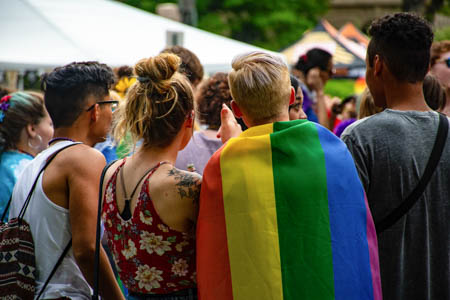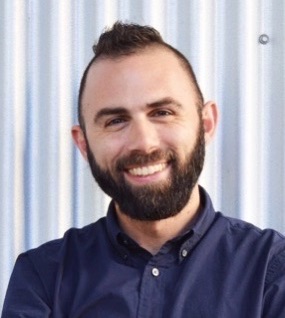A growing number of young people are identifying as part of the LGBTQ+ community, and many are challenging binaries in gender and sexual identity to reflect a broader spectrum of experience beyond man or woman and gay or straight. But not everyone is participating equally in these diverse forms of expression, according to new research from the University of California, Santa Cruz.
Psychology Professor Phillip Hammack’s latest paper, published in the Journal of Adolescent Research, is shedding light on the social factors that can either hinder or support expression of diversity in sexual and gender identity among teens and young adults.
“I think the language is finally evolving to represent the actual diversity of experience that exists,” Hammack said. “On the one hand, teens seem much more liberated and have a much more expansive vocabulary than previous generations, but you also still have these unresolved issues around things like masculinity. So that was the real shock to me.”
In particular, the paper found that regional differences and pressures to conform to masculinity may have a dampening effect on diversity of expression.
Identifying regional differences
Hammack’s research focused on teens between the ages of 14 and 18, who are among the younger members of Generation Z. Researchers wanted an in-depth understanding of these young people’s experiences, so they performed detailed research at a small number of field sites in the San Francisco Bay Area and California’s Central Valley.
These sites were selected to represent higher and lower levels of resources, rights, and visibility for sexual and gender diversity. Within these communities, researchers surveyed 314 LGBTQ+ teens and conducted extensive interviews with 28 LGBTQ+ youth informants and 24 adult LGBTQ+ leaders.
Almost a quarter of all LGBTQ+ youth surveyed expressed some form of nonbinary gender, and use of they/them pronouns was common. But there was a difference of more than 11 percentage points in the proportion of youth expressing nonbinary gender identity in the Bay Area compared to the Central Valley. Some study participants told researchers that, while they felt diverse sexuality is becoming more broadly normalized, gender diversity is still less accepted.
“It was hard to hear all of the difficulties that the participants were going through and challenges with not feeling safe being out or having access to the resources they needed,” said Julianne Atwood, a coauthor on the paper who conducted field interviews with Central Valley participants. “It’s tough being a queer person in a rural community, but it does get better.”
Researchers found that there was less open discussion of sexual diversity in Central Valley communities compared to the Bay Area, but in this case, there was no corresponding difference in diversity of sexuality labeling. Study participants often mentioned finding information through the internet and social media, rather than their geographic communities.
“Being online is kind of like the great equalizer for LGBTQ youth, and I think that benefits them all tremendously,” Hammack said.
The pressures of masculinity
Researchers also noticed that teens who were assigned female at birth seemed more comfortable with diverse forms of gender expression. Among teens in the study group who identified with a nonbinary gender label, 78.7 percent were assigned female at birth. There were also notably more transgender boys in the study than transgender girls.
During interviews, study participants consistently shared stories of how those who were assigned male at birth faced strong pressures to conform to standards of masculinity. Accounts of violence against transgender women of color were common in interviews, along with other fears that it might not be safe for those assigned male at birth to express nonconforming gender or sexual identities.
Hammack said he believes harmful “regulation of masculinity” may stem from feelings of insecurity among boys as gender hierarchies are being challenged. The paper’s documentation of these trends will be an important contribution to the future of LGBTQ+ research and support, said Stephen Russell, a prominent sociologist and professor at the University of Texas at Austin who served as a scientific advisor on the project.
“I know that I’ll cite this work for the way they link gender normativity and the pressures of masculinity for boys,” Russell said. “There are different imperatives and possibilities for young people if they are assigned female at birth or if they’re assigned male at birth, and this shows what that means for how they can understand themselves in the world.”
Reaching teens across labels
Ultimately, perceptions of gender and sexuality labels can affect which types of resources and support are most accessible for teens. For example, Hammack said that cisgender gay males in the research areas were noticeably missing from LGBTQ+ support groups, which may indicate that these spaces are being perceived as “feminine.”
Similarly, the study found that some identity labels are racialized in ways that may make boys of color less likely to identify with them. But targeted recruitment efforts could help LGBTQ+ support groups for teens to better reflect the true diversity of the community.
Hammack hopes his research might offer a window into that diversity to create greater acceptance and recognition across all labels.
“I’ve actually been trying to shift my speech away from saying LGBTQ+, with that uncomfortable plus sign, because there are so many identities that are not captured within that label,” Hammack said. “I’ve been thinking about these issues instead as phenomena of sexual and gender diversity, and I’d like to see more researchers and educators recognizing those nuances within the community.”




